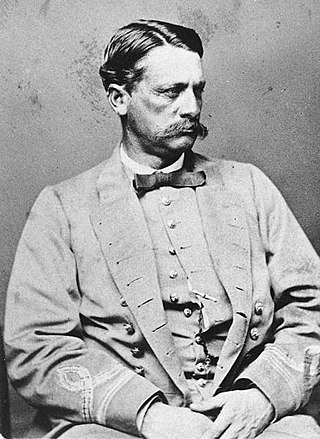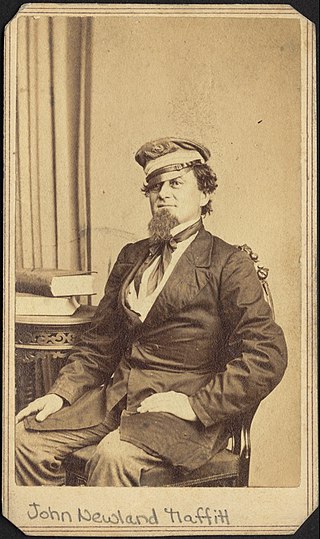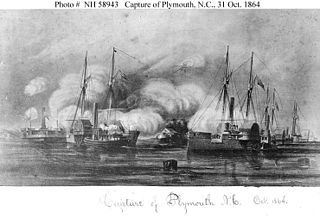
CSS Albemarle was a steam-powered casemate ironclad ram of the Confederate Navy, named for an estuary in North Carolina which was named for General George Monck, the first Duke of Albemarle and one of the original Carolina Lords Proprietor.

The Confederate States Navy (CSN) was the naval branch of the Confederate States Armed Forces, established by an act of the Confederate States Congress on February 21, 1861. It was responsible for Confederate naval operations during the American Civil War against the United States's Union Navy.

The Confederate States Marine Corps (CSMC), also referred to as the Confederate States Marines, was a branch of the Confederate Navy during the American Civil War. It was established by an act of the Provisional Congress of the Confederate States on March 16, 1861. The Corps' manpower was initially authorized at 46 officers and 944 enlisted men, and was increased on September 24, 1862, to 1,026 enlisted men. The organization of the Corps began at Montgomery, Alabama, and was completed at Richmond, Virginia, when the capital of the Confederate States was moved to that location. The headquarters and main training facilities remained in Richmond throughout the war, located at Camp Beall on Drewry's Bluff and at the Gosport Shipyard in Portsmouth, Virginia. The last Marine unit surrendered to the Union army on April 9, 1865, with the Confederacy itself capitulating a month later.
CSS North Carolina was a casemate ironclad built for the Confederate Navy in 1863 during the American Civil War by Berry & Brothers at Wilmington, North Carolina at a cost of $76,000. She was placed in commission during the latter part of the year with Commander W. T. Muse, CSN, in command.

CSS Shenandoah, formerly Sea King and later El Majidi, was an iron-framed, teak-planked, full-rigged sailing ship with auxiliary steam power chiefly known for her actions under Lieutenant Commander James Waddell as part of the Confederate States Navy during the American Civil War.

James Iredell Waddell was an officer in the United States Navy and later in the Confederate States Navy.

CSS Florida was a sloop-of-war in the service of the Confederate States Navy. She served as a commerce raider during the American Civil War before being sunk in 1864.

John Newland Maffitt was an officer in the Confederate States Navy who was nicknamed the "Prince of Privateers" due to his success as a blockade runner and commerce raider in the U.S. Civil War.

CSSEllis was a gunboat in the Confederate States Navy and the United States Navy during the American Civil War. It was lost during a raid while under command of famed Navy officer Lieutenant William B. Cushing.

CSS Raleigh was originally a small, iron-hulled, propeller-driven towing steamer operating on the Albemarle and Chesapeake Canal. She was taken over by the State of North Carolina in May 1861, and transferred to the Confederate States the following July. Her commanding officer during 1861–1862 was Lieutenant Joseph W. Alexander. Her entire service was in coastal waters of North Carolina and Virginia and in the James River as part of the James River Squadron.
CSS Raleigh was a steam-powered Civil War casemate ironclad. She was fitted with a spar torpedo instead of an iron ram and was built in 1863–1864 by the Confederate States Navy at Wilmington, North Carolina. While she was being built her commander was Lieutenant John Wilkinson (CSN). She was put into commission on April 30, 1864 under the command of Lieutenant J. Pembroke Jones, CSN.
The CSS Beaufort was an iron-hull gunboat that served in North Carolina and Virginia during the American Civil War. Originally launched as Caledonia at Wilmington, Delaware, in 1854, the ship was owned by James Cathcart Johnston. It saw use as a tugboat on the Dismal Swamp Canal. On July 9, 1861, Beaufort was commissioned into the navy of the state of North Carolina for use in the American Civil War. First serving on the North Carolina coast, Beaufort was present at the battles of Roanoke Island and Elizabeth City in February 1862. Escaping the Confederate defeat at Elizabeth City via the Dismal Swamp Canal, Beaufort reached Norfolk, Virginia, where she joined the James River Squadron.

The Battle of Elizabeth City of the American Civil War was fought in the immediate aftermath of the Battle of Roanoke Island. It took place on 10 February 1862, on the Pasquotank River near Elizabeth City, North Carolina. The participants were vessels of the U.S. Navy's North Atlantic Blockading Squadron, opposed by vessels of the Confederate Navy's Mosquito Fleet; the latter were supported by a shore-based battery of four guns at Cobb's Point, near the southeastern border of the town. The battle was a part of the campaign in North Carolina that was led by Major General Ambrose E. Burnside and known as the Burnside Expedition. The result was a Union victory, with Elizabeth City and its nearby waters in their possession, and the Confederate fleet captured, sunk, or dispersed.

Black Warrior is the name of a Confederate two-masted schooner that participated in the defense of Roanoke Island in North Carolina during the Civil War. Its brief wartime career ended with its burning at Elizabeth City, North Carolina.

The Battle of Plymouth was an engagement during the American Civil War that was fought from April 17 through April 20, 1864, in Washington County, North Carolina.
USS Whitehall was a steamer acquired by the Union Navy during the American Civil War. She was assigned blockade duty; however, her condition was not always considered seaworthy, and she was plagued with condition problems.
USS Morse was a ferryboat acquired by the Union Navy during the American Civil War.
The first USS Adirondack was a large and powerful screw-assisted sloop of war with heavy guns, contracted by the Union Navy early in the American Civil War. She was intended for use by the Union Navy as a warship in support of the Union Navy blockade of Confederate waterways. Her career with the Navy proved to be short, yet active and historically important. USS Adirondack was one of four sister ships which included the Housatonic, Ossipee and Juniata.
The Battle of Pig Point was an early naval battle of the American Civil War, after Lincoln had extended the Union blockade to include Virginia. On June 5, 1861, the Union gunboat USRC Harriet Lane under Captain John Faunce was ordered to attack Pig Point, but due to shallow water, the shots fell short, and the Union suffered five men wounded before withdrawing.

CSS Huntsville was a Confederate ironclad floating battery built at Selma, Alabama, from 1862 to 1863 during the American Civil War.
W. Craig Gaines, Encyclopedia of Civil War shipwrecks. Louisiana State University Press, 2008.














